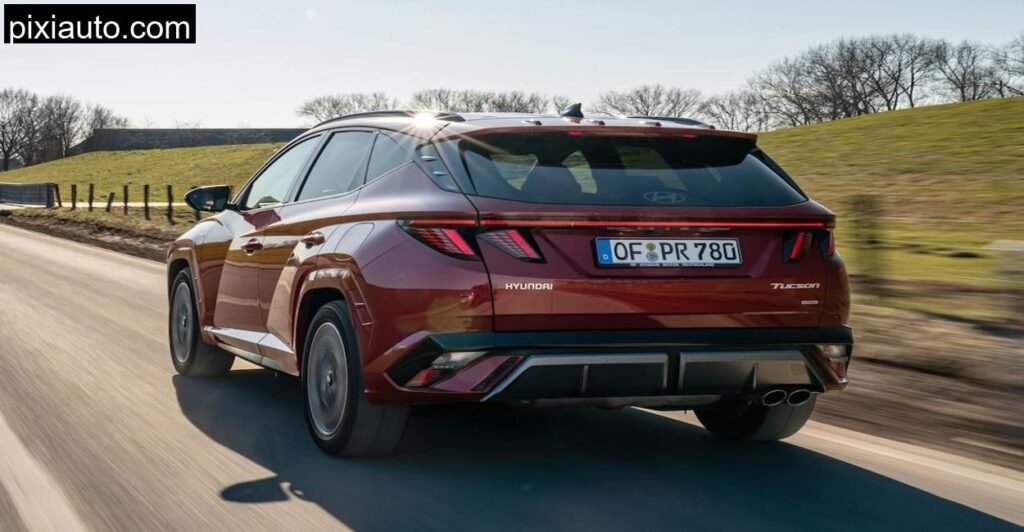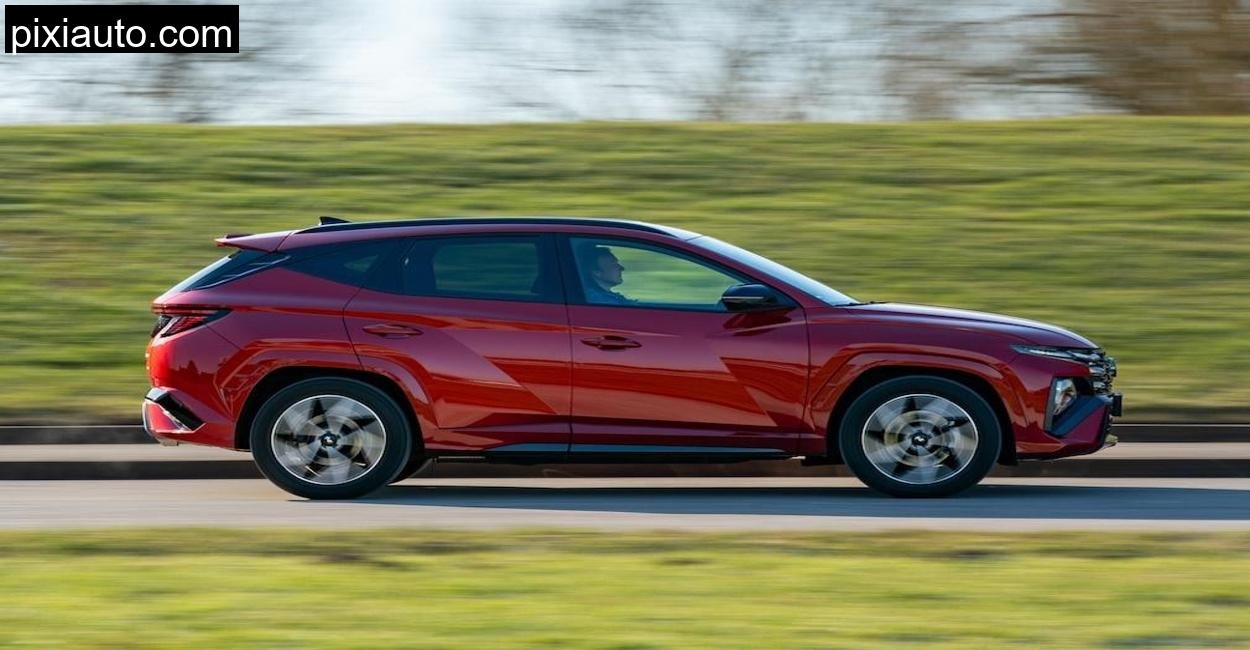Somewhere between the curving ridgelines of the Solling uplands, where the spruce, heavy landscape hums with ancient peace, I spent a long weekend living with a car that wants to be everything: family crossover, efficient urban commuter, and soft, roader with a nod toward freedom. That car is the Hyundai Tucson 1.6 T, GDI 48V with all, wheel drive and a seven, speed dual, clutch transmission. On paper, it sounds like a lot. On the gravel paths and winding B, roads of the Lower Saxon forest, it turned out to be even more. Or less, depending on what you expect.
Before I dive into the real, world tangibility of this Korean crossover, let’s clear the tech specs. They matter, but more importantly, how they feel in the wilds of Germany, those muddy forest pull, offs and smooth, narrow tarmac lanes, is what counts. The Tucson came to me clad in N Line trim, wearing a sort of understated urban armor, and it promised comfort, digital sophistication, and just enough bite to climb and corner confidently.
Technical Specifications
Every technical specification is obtained directly from the official Hyundai website for accuracy.
| Specification | Details |
| Engine type | 1.6L turbocharged four, cylinder (MHEV) |
| Electric system | 48V mild hybrid starter, generator |
| Power output | 160 hp (118 kW) @ 5500 rpm |
| Torque | 265 Nm @ 1500 rpm |
| Transmission | 7, speed dual, clutch automatic (DCT) |
| Drive type | All, wheel drive |
| 0, 100 km/h | 9.8 seconds |
| Top speed | 192 km/h |
| Fuel consumption (test) | 8.7 l/100 km |
| CO₂ emissions | 206 g/km |
| Vehicle length | 4520 mm |
| Width (with mirrors) | 2130 mm |
| Height | 1650 mm |
| Wheelbase | 2680 mm |
| Seat height | 675 mm |
| Boot capacity | 577 , 1756 liters |
| Towing capacity | 1510 kg |
| Curb weight | 1644 kg |
| Payload | 546 kg |
| Tank capacity | 54 liters |
| Warranty | 5 years |
| Price | From €42,610 |
Solling’s Curves and the Tucson’s Composure
When I picked up the Tucson, I didn’t quite know what to expect. There’s something about mid, sized SUVs that often feels like compromise, too heavy for sport, too soft for off, road, too diluted for identity. But as soon as I left the town and climbed into the wooded backbone of the Solling, the Tucson’s composure started to shine. It sat well on its 19, inch wheels, never bouncing or shuddering through the tight, broken sections of forest road. There’s a subtle firmness to the N Line suspension, not quite sporty but deliberate, like the car knows where it wants to be.
The all, wheel, drive system, quietly managing grip in the background, proved useful on damp inclines and sharp gravel corners. It’s not a rock crawler, but on wet forest soil and patchy asphalt, it gave me the freedom to keep momentum without hesitation. There’s no dramatic torque, vectoring or active terrain wizardry here, just a system that works efficiently and without fuss.
Cabin Life: Digital Brilliance, Slight Ergonomic Misfires

Sliding into the Tucson’s cabin after a day of wet hiking boots and misty mountaintop views was always comforting. Two sharp 12.3, inch displays greeted me each time with minimalist confidence. The infotainment system is responsive and modern, with wireless Apple CarPlay and Android Auto working without a hitch. The navigation updated itself on the go, and I rarely had to fiddle with anything while driving. Hyundai’s voice assistant is polite but still feels a bit mechanical, it understood “I’m cold” and responded by blasting warm air, but more casual commands fell flat.
Storage inside is generous. There’s a huge bin between the seats (a little too wide, actually, I lost a snack bar down there that I never recovered), multiple USB, C ports, and even rear seat ventilation and charging. The “Sport Comfort Seats” up front, though, had me torn. They look supportive and boast lumbar support and heating, but they lack any extendable under, thigh support. After three hours of spirited driving around the Solling, I found myself wishing for more contour and a slightly softer seat base.
The rear seats, on the other hand, are a win. There’s proper room, reclining functionality, and enough height to feel commanding. Passengers had nothing but praise, especially with the panoramic sunroof letting light pour in through the dense green canopy above.
Performance: Calm, Controlled, Slightly Thirsty
The 1.6, liter turbocharged engine doesn’t shout performance, and it doesn’t try to fake it either. Its strength lies in its smooth delivery and seamless pairing with the dual, clutch gearbox. Around town and on the long, climbing roads outside Neuhaus, it shifted cleanly and quietly, never hunting for gears or hesitating. When I asked for power, it responded with a measured hum and enough torque to pass a truck uphill without stress.
But it’s not a punchy drivetrain. You don’t get that quick, jab acceleration some turbo SUVs offer. Instead, the Tucson leans on its mild hybrid system to keep things efficient and seamless. Regrettably, that 48V system didn’t do much for real, world economy, I averaged 8.7 liters per 100 kilometers even when trying to be gentle. In traffic, I sometimes saw it creep down into the low 8s, but climbing mountain roads pulled it right back up.
Still, the car never felt underpowered. It’s a cruiser, not a bruiser. And in that role, it does an admirable job, quiet, stable, and confident, even when wet leaves and steep gradients enter the picture.
Practicality and Everyday Versatility

Where the Tucson really excels is in everyday living. Its boot space is immense. I packed two mountain bikes (wheels off), a weekend’s worth of hiking gear, and enough groceries to last a siege, and still had room for a crate of beer and muddy boots. The floor is flat, with clever storage beneath and a low loading lip. The seats fold easily in a 40:20:40 split, and they do so without leaving annoying steps or bumps.
For families, the Tucson is a quiet hero. The back seats are ISOFIX, ready and even big child seats don’t dominate the cabin. The ride quality never dips into floaty or crashy territory, and that matters when hauling delicate passengers or open coffee mugs.
Even in tighter village streets near Uslar, it was manageable. The steering isn’t as light as a compact hatchback’s, but visibility is great, the cameras are crystal clear, and it turns tighter than it looks.
Conclusion: Forest, Proof and City, Ready
Driving the Hyundai Tucson AWD in the Solling felt like meeting a car that understands balance. It doesn’t try to be the fastest, flashiest, or even the most efficient in its class. Instead, it blends capability, comfort, and digital usability into a machine that can take you from the urban jungle to a foggy forest clearing without changing its shoes.
It’s not perfect, the fuel economy feels behind the curve for a hybrid, and the seats could use more long, distance support, but it’s real. And real is what matters when you’re on a narrow forest road, windows fogged from a chilly morning, and you need the car to just do its job. The Tucson does, and it does so with grace.
Is the Tucson’s mild hybrid system noticeable in daily driving?
Not really, it operates quietly and automatically, giving you small efficiency boosts during braking and acceleration. But it doesn’t dramatically affect how the car feels or drinks fuel.
Can the Tucson handle mild off, road trails like forest paths or gravel roads?
Yes. Its AWD system is competent for light adventure use. It won’t replace a hardcore off, roader, but it’s confident on slippery or uneven surfaces.
How’s the Tucson for long, distance driving?
Mostly very good, quiet, composed, and with helpful digital tools. The only drawback is the seat support during longer stints.



Leave a Comment